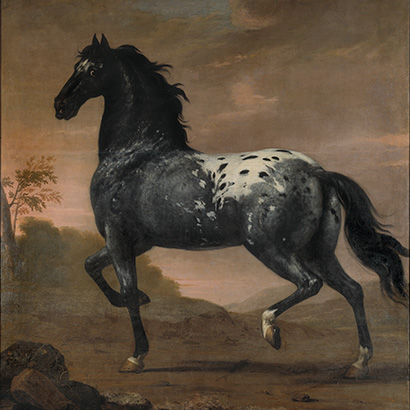
Ehrenstrahl's equine portraits
At a young age, Karl XI received around twenty horses as a gift from the royal families of Spain and France. He then commissioned portraits of five of his favourites by the artist David Klöcker Ehrenstrahl. The portraits hang in the Hall of State at Strömsholm Palace.
By his own account, Karl XI often happily stayed at Strömsholm Palace, where he devoted his time to two of his favourite hobbies – riding and hunting.
In those days, people were hugely dependent on horses for transport and as work tools, so it was natural to also acquire skills in assessing horses, prizing particularly impressive examples, and appreciating their performance qualities.
This primarily applied to those who could afford to keep numerous horses and those who were employed to care for these horses, while normal people – if they had any horses at all – simply had to make do with whatever luck gave them.
Horses provided social status
Karl XI was interested in horses, for both driving and riding, from an early age. For him, over the years, travelling became increasingly a matter of performance rather than transportation. His diary overflows with details of how long the journeys took, or how many times he was obliged to change horses between Strömsholm and Stockholm, Uppsala and Ulriksdal, or Kungsör and Strängnäs.
Many horses and expensive horses gave the owners greater social status. Noble horses were a royal attribute, and became costly and popular gifts between rulers.
Gifts from the royal courts
As a mere 17- or 18-year-old, Karl XI received around twenty horses as a gift from the Spanish and French royal courts.
We do not know what then made him commission life-size portraits of five of his favourites from Ehrenstrahl in 1673.
Unique equine gallery
We do however understand something of the horses' significance to him, as between 1680 and 1684 he commissioned portraits of a further six, and the same number again in 1689.
The result is a unique gallery of equine portraits, which in the 18th century likely amounted to more that twenty paintings. Of these, seventeen portraits remain, seven of which are permanently displayed at Strömsholm Palace.

King Karl XI riding a brown-spotted buckskin rearing stallion with a long white tail. Stockholm can be seen in the background. The 1671 oil painting by Ehrenstrahl hangs at Drottningholm Palace. Photo: Nationalmuseum
_-_Nationalmuseum.jpg)
David Klöcker Ehrenstrahl's self-portrait. Inscribed: "This depiction of His Majesty's Surveyor to the Royal Household David Klöcker Ehrenstrahl was painted in 1691, in his 62nd year, and is intended to represent love of painting." Photo: Anna Danielsson/Nationalmuseum

King Karl XI's life horse Blue Tiger, painted by Ehrenstrahl in 1673. The portrait hangs at Gripsholm Castle. Photo: Nationalmuseum










